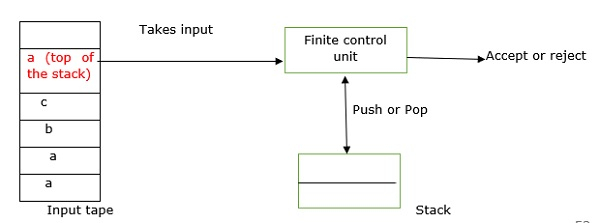
 Data Structure
Data Structure Networking
Networking RDBMS
RDBMS Operating System
Operating System Java
Java MS Excel
MS Excel iOS
iOS HTML
HTML CSS
CSS Android
Android Python
Python C Programming
C Programming C++
C++ C#
C# MongoDB
MongoDB MySQL
MySQL Javascript
Javascript PHP
PHP
- Selected Reading
- UPSC IAS Exams Notes
- Developer's Best Practices
- Questions and Answers
- Effective Resume Writing
- HR Interview Questions
- Computer Glossary
- Who is Who
Compare Push down automata and Linear bounded automata
Let us understand the push down automata (PDA) and the linear bounded automata (LBA) in the theory of computation (TOC).
Push-Down Automata
A PDA can be formally described as seven tuples (Q, Σ,S, δ,q0,I,F)
Where,
- Q is finite no of states
- Σ is input alphabet
- S is stack symbol
- Δ is the transition function: QX(ΣU{e})XSXQ
- q0 is the initial state (q0 belongs to Q)
- I is the initial state top symbol
- F is a set of accepting states (F belongs to Q)
A Push-Down Automaton is a finite-state machine that is equipped with a memory device that functions as a push-down store.
Push-down automata are equivalent to context-free grammars, also known as the Chomsky Type 2 grammars, which means that, given a context-free grammar G, a push-down automaton A can be devised that recognises just the sentences generated by G.
This relationship between context-free grammars and push-down automata was first described by Chomsky (1962), The machine closely related to a push-down automaton that was employed earlier by Yngve (1960) to model the transient memory required by the human processor to analyse the sentences with a various different structures which is generated by context-free grammars.
The essentials of his method are still applied in studies of short-term memory and sentence processing with the store of a push-down automaton that serves as a model of transient memory employed to analyse sentences with different structures.

Components of PDA
A Push-Down Automaton consists of four components −
- A Control Unit.
- A Read Unit.
- An Input Tape.
- A Memory Unit.
The operations of the unit’s control, read, and tape are same as those of a finite-state automaton, except that the transitions executed by the control unit of a push-down automaton involve the operations to store symbols, and retrieve symbols from the memory unit.
The memory unit of a push-down automaton operates as a stack or push-down store, which leads to the name for this variety of abstract machine.
Linear bounded automata
A linear bounded automaton (LBA) is called a multi-track Turing machine which has only one tape which is exactly the same length as the input. That seems quite reasonable. We allow the computing device to use just the storage it was given at the beginning of its computation.
As a safety feature, we shall employ end markers on our lba tapes and never allow the machine to go past them. This will ensure that the storage bounds are maintained and help keep our machines from leaving their tapes. At this point, the question of accepting sets arises. Let's have linear bounded automata accept just like Turing machines.
Thus for LBA halting means accepting. For these new machines computation is restricted to an area bounded by a constant (the number of tracks) times the length of the input. This is very much like a programming environment where the sizes of values for variables are bounded.

